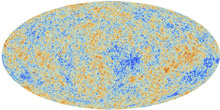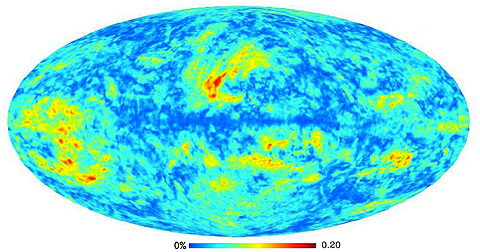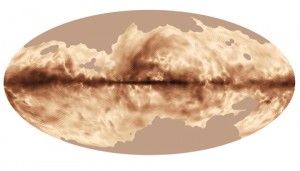New analyses suggest that observations heralded as evidence for the universe’s brief growth spurt don’t conclusively show what researchers thought they did.

Hubbub is a-bubbling in cosmology right now. In March, the BICEP2 team announced that they’d detected swirling polarization patterns called B-modes in the cosmic microwave background (CMB), the leftover radiation from the universe’s birth. These patterns should exist in the CMB if the universe underwent a moment of exponential expansion called inflation that lasted roughly a nano-nano-nano-nanosecond.
The announcement set off fireworks-level excitement and speculations about a Nobel prize for the theorists who first proposed inflation, if the result was confirmed.
But now, two other teams have combined the BICEP2 data with the latest release from the Planck mission and are painting a different picture. Both these teams say they can’t distinguish whether the B-modes the BICEP2 team detected are in the CMB or in the emission from dust filling our own galaxy.
This blog is long because the issue is complicated and deserves careful treatment. But if you take one thing away from this article, let it be this: we don’t know what the correct answer is yet. But we soon might. The back-and-forth we’re experiencing now is simply how science works.
Confusing Signals
The problem is twofold. One, we’re stuck in a galaxy. Looking at the cosmos from inside the Milky Way is like looking at a road through a fogged, bug-spattered windshield. Observers have to peel away all this “foreground” stuff so that they can see the CMB.
At the frequency BICEP2 observed, the three main signals we care about are the CMB (which is polarized at a level we’re trying to figure out), dust (also polarized), and the cosmic infrared background (CIB, unpolarized). The CIB is the sum of infrared light from billions of unresolved, dusty galaxies, and it suffuses the cosmos in much the same way that the CMB does.

To tease out the CMB’s signal, cosmologists must identify how much of the signal they observe from a given part of the sky comes from each source. To do this, the BICEP2 team used a preliminary all-sky map of polarized dust emission, taken from a conference presentation given by a Planck team member in April 2013.
But this map included the CIB. Because the CIB is just integrated light from dust in a whole bunch of galaxies, it looks like the dust in the Milky Way — except it’s not polarized. If you look at the whole dusty signal together, it looks like about 5% of the emission is polarized. But if half the signal in there is unpolarized and you remove that part, the “fractional polarization” of what’s left goes up, maybe to 10% (I’m using rough numbers here).
The Planck team knew the CIB was a problem and spent a year weeding it out. They released a preliminary CIB-less dust map several weeks ago.
It’s this second map that the two new papers are using. With the revised polarized dust map, a team from University of California, Berkeley, and another team from Princeton and New York University say the BICEP2 team might have lowballed the amount of polarization that comes from the Milky Way’s dust. In other words, we can’t conclude anything about where the B-modes BICEP2 sees come from.
Frequency Matters in Cosmology
There’s a big BUT here, the #2 of the twofold problem: all the teams are extrapolating.
The Planck polarization map is at 353 GHz, where the dust emission is strong. But BICEP2 observed at 150 GHz. So cosmologists have to take a three-step approach, explains Planck scientist Charles Lawrence (JPL).
First, they need to know how much of the galactic dust emission at 353 GHz is polarized. Second, the strength of the galactic dust signal is different at different frequencies, so they need to correctly deduce what the signal looks like at 150 GHz, where the dust emission is weaker. Third, they need to correctly split that polarization signal into its two types, E-modes and B-modes.

The BICEP2 team extrapolated to 150 GHz using a 353-GHz, CIB-tainted map of the section of sky that they observed. The two other teams extrapolated using a 353-GHz map that’s clean of the CIB but doesn’t include the BICEP2 field of view. The Planck team hasn’t released the data for regions near the north and south galactic poles because the observations of those sectors are ridiculously hard to analyze. And BICEP2 looked at the Southern Hole.
The Planck team is taking so long because the scientists are working on a cosmic scale. The Planck satellite observed the CMB to high precision in order to measure the numbers that characterize the universe, things related to its expansion speed and density and so forth. The team has to correlate all these observations and calculations with one another before they’re finished.
“It’s not like you can have a result over here on one side that is inconsistent with another on the other side, and then say, ‘Oh whoops, we didn’t notice that,’” Lawrence says, laughing. It all has to fit together. “This is just hard work and it has to be done right. So it takes as long as it takes.”
The Planck data are important in part because they’ll obviate the need to extrapolate. Planck measured polarization at 30, 44, 70, 100, 143, 217, and 353 GHz. In the units that the cosmologists use to make their maps, the CMB signal doesn’t change as you look in different frequencies. But the dust signal does. So if researchers can look at how the signal changes as they move between frequencies, they can effectively wipe the dust off their cosmic windshield.
Several sources have reported that Planck’s results will be out in October. The real deadline is the first week of December, because that’s when the next Planck conference is scheduled. They might be out earlier, in part or in total, but the conference deadline is drop-dead, Lawrence says. These results will include the temperature and polarization data from the full mission; the previous release in 2013 included only the first half of the temperature data. It’s too soon to say whether the upcoming release will include Planck’s version of direct B-mode measurements.
The fact that the BICEP2 result hinges on Planck’s data has upped the stakes. “There’s one thing that everybody agrees on, and that is we have to be right,” Lawrence stresses. “We cannot afford to be wrong about this. And if it takes a little bit longer, and we say ‘Well, what about—? Or have we checked this?’ or so on, then that’s going to happen. Until that’s done, it’s not done.”
That’s life in the messy universe.
References:
M.J. Mortonson and U. Seljak. “A joint analysis of Planck and BICEP2 B modes including dust polarization uncertainty.” Posted to arXiv.org May 22, 2014.
R. Flauger, J.C. Hill, and D.N. Spergel. “Toward an Understanding of Foreground Emission in the BICEP2 Region.” Posted to arXiv.org May 28, 2014.
Planck Collaboration. “Planck Intermediate Results. XIX. An Overview of the Polarized Thermal Emission from Galactic Dust.” Posted to arXiv.org May 5, 2014.
BICEP2 Collaboration. “BICEP2 I: Detection of B-mode Polarization at Degree Angular Scales.” Posted to arXiv.org March 18, 2014.
 11
11









Comments
Peter Wilson
June 2, 2014 at 8:06 pm
Assuming they checked the connectors?
Seriously, “something” set the universe in motion, Inflation or Otherwise, something beyond any physics known today. The signal will probably eventually be lifted from the noise, confirming that the impossible happened at the beginning, as per the Inflation model‘s predictions. I am betting on the B-mode polarization flavored impossibility, because the alternative is even more impossible!
You must be logged in to post a comment.
Robert-McCabe
June 3, 2014 at 9:16 am
"The back-and-forth we’re experiencing now is simply how science works."
Unless you are talking about climate change...
You must be logged in to post a comment.
Lou
June 4, 2014 at 8:38 am
Aye, science is often messy, but I can't help feeling that the BICEP2 team could have made it a lot less messy by simply waiting for the raw Planck data to be released. I'm guessing they wanted to beat their competitors (POLARBEAR etc.) to Stockholm. 😉 X
You must be logged in to post a comment.
Eric-Lerner
June 5, 2014 at 10:07 pm
The embarrassing errors made by S and T journalists (along with many others) in jumping on the non-reviewed BICEP 2 results just because they confirmed popular theoretical fancies should be a warning that the press is treating the fashionable cosmological model with too much credulity and too little skepticism. Taking inflation, dark energy, and dark matter—none confirmed in the laboratory--as Gospel is not the scientific method, nor good reporting of it. There is new, real, peer-reviewed evidence the universe is NOT expanding—here http://arxiv.org/abs/1405.0275 , with explanations here http://lawrencevilleplasmaphysics.com/new-evidence-that-the-universe-is-not-expanding/ and a presentation at Oxford University here https://www.youtube.com/watch?v=L0q_pG8FnxQ. It would be good to report on that—even with all the caveats that important results should always get.
You must be logged in to post a comment.
Peter Wilson
June 7, 2014 at 4:40 pm
If I’m understanding it correctly, your paper strengthens a long-standing observation/conundrum? What I missed in the video is the expected fall-off in surface-brightness in the expanding universe model. In other words, density was higher in the past, so we expect a higher star formation-rate back then, which translates to a higher SB. Going forward in time, both the growth of galaxies and the fall in density of star-making material conspire to decrease SB with time. I only caught mention of the first effect. My feeling is that your results are consistent with an expanding universe.
You must be logged in to post a comment.
MSc. Jorge Poveda
June 6, 2014 at 4:59 pm
Science is well known never moves in a straight line. There is always turning back and reconsideration of hypotheses when the evidence did not prove. The Big Bang theory is a hypothesis-respectable and quite logical, but not necessarily the complete answer to the question: How the Universe was born ..? . Maybe we never will access the unique and complete answer. And although we can access that elusive answer other questions would arise....
You must be logged in to post a comment.
Jason-Buczyna
June 7, 2014 at 12:55 pm
I think that Eric's recent paper can be objected to as follows: while the authors did a good job of making sure that they weren't just comparing young, bright, star-forming galaxies that formed a long time ago with old, dimmer galaxies of today, they didn't take into account the fact that the young galaxies that form in at early cosmological ages will form in an environment with far fewer metals than those of today, so the stars in these galaxies will result in intrinsic surface brightnesses will be MUCH brighter in intrinsic surface brightness than the starburst galaxies of today.
As for the general tone, though, the BICEP2 results were very exciting, and the group was obviously well-managed, so it is quite understandable that responsible journalists will report news of such an occurrence. In terms of philosophy of science, I think that the general tune above is wrong: just because there is a hiccup in the verification process of a well-established theory, this isn't cause to reject the entire scenario. Just because YOU (the word here being used to mean "the reader") can't explain something doesn't mean that it's entirely wrong and we must go back to the drawing board. While there are a few such instances in big bang cosmology, the problems in plasma cosmology are far worse and far more significant (while those in big bang cosmology are relatively trivial in comparison). (Explaining spectrum of element abundances is one of the main problems, especially now with modern computer simulations of various types of stars.) Science attempts to take the best model out there and continuously refine it.
You must be logged in to post a comment.
Eric-Lerner
June 9, 2014 at 11:38 pm
First, to make good predictions, you want as few free parameters fitted to the data as possible—Kepler’s ellipses, not Ptolemy’s epicycles. The non-expanding model has only one free parameter—Hubble’s constant—yet it fits both the SN1A data and the SB data. The expanding model needs 3 free parameters to fit the SN1A data. You can invent a mathematical fit of expanding galaxies to the SB data, but you will need at least two free parameters to do it--a total of five parameters to fit both data sets. Where’s Occam’s razor when we need it? And you end up having to argue that is just a coincidence that an expected SB dimming of between 8 (at z=1) and 216 (at z=5) is EXACTLY compensated by brighter SB in the past—so the two effects just happen to cancel to within a few percent. Second, you have to argue that ellipticals, which are producing almost no stars at all, grow at the exact same rate as these ultra-bright spirals, which are very young, rapidly star-forming galaxies. Third, there are all the other problems of the Big Bang outlined in the Oxford lecture—not just this one. At what point do you say this model is falsified? Never?
You must be logged in to post a comment.
Peter Wilson
June 10, 2014 at 8:27 pm
Let’s talk about the number of free parameters. The basic standard-model had only two: density rho, and expansion rate H. The luxury edition includes the ratio of photons to baryons; radiation temperature; and percentage dark-matter. But until 1998, when observations forced the addition of lambda, or dark-energy, the working model had only two free parameters. It’s my contention that this model was fatally underspecified to begin with. Our universe is not a uniformly expanding ideal gas. As you say about 20 minutes into the talk, “galaxies (should not be) growing in proportion to the size of the universe…because they are gravitationally bound objects.” My emphasis. The universe is not uniformly expanding, as in the Friedmann equations. It is clumping on the scale of galaxy clusters. To include clumping in the model requires at least two additional free parameters, one of which is Ri, the distance between clumps.
Before ditching the standard model altogether, I strongly suggest you look at what I am saying it is missing. It takes a minimum of four free parameters to describe a gravitational system, like our universe, that is both collapsing locally and expanding non-locally.
You must be logged in to post a comment.
Eric-Lerner
June 12, 2014 at 1:21 am
Actually, Mike Disney’s paper shows 20 free parameters in the Big Bang theory at that time. The non-expanding model right now has either one—Hubble—or two, if you include MOND acceleration parameter. I showed in a paper over twenty years ago that the size and average spacing of galaxies, clusters and superclusters can be calculated from plasma physics and gravity with no free parameters. In both cases you can find the citations here:http://lawrencevilleplasmaphysics.com/cosmic-connection/plasma-cosmology/the-growing-case-against-the-big-bang/
You must be logged in to post a comment.
Peter Wilson
June 14, 2014 at 11:25 am
Eric, I whole-heartedly agree that the standard model has real problems, and I applaud your efforts to address them. I’m trying to offer help. You’re pointing at the failed predictions and the forest of parameters. I’m pointing to an oversight three steps back…about 1922 in Mike Disney’s somewhat confusing Table 1. If I give you the density and expansion-rate of the Earth-Moon system, can you tell me whether that expansion is accelerating or decelerating? No. Yet the Friedmann equations, sans lambda, purport to do exactly that for the universe. It didn’t work. To answer questions about a gravitational system, in general, one needs more than its density and expansion rate. In my example, in order to correctly predict that the expansion of the Moon’s orbit is accelerating, one needs: the Earth’s mass; the Moon’s mass; the distance between them; and Earth’s rotation rate. A two-parameter model of the Earth-Moon system leave it causally incomplete. Ditto for the universe.
Remedying the causal incompleteness of the Friedmann equations may neither rescue nor topple the BBC. But one should always fix the known problem first. On the other hand, if you’re happy with the standard model: don’t rock the boat. Keep moving folks…there’s nothing to see.
You must be logged in to post a comment.
You must be logged in to post a comment.